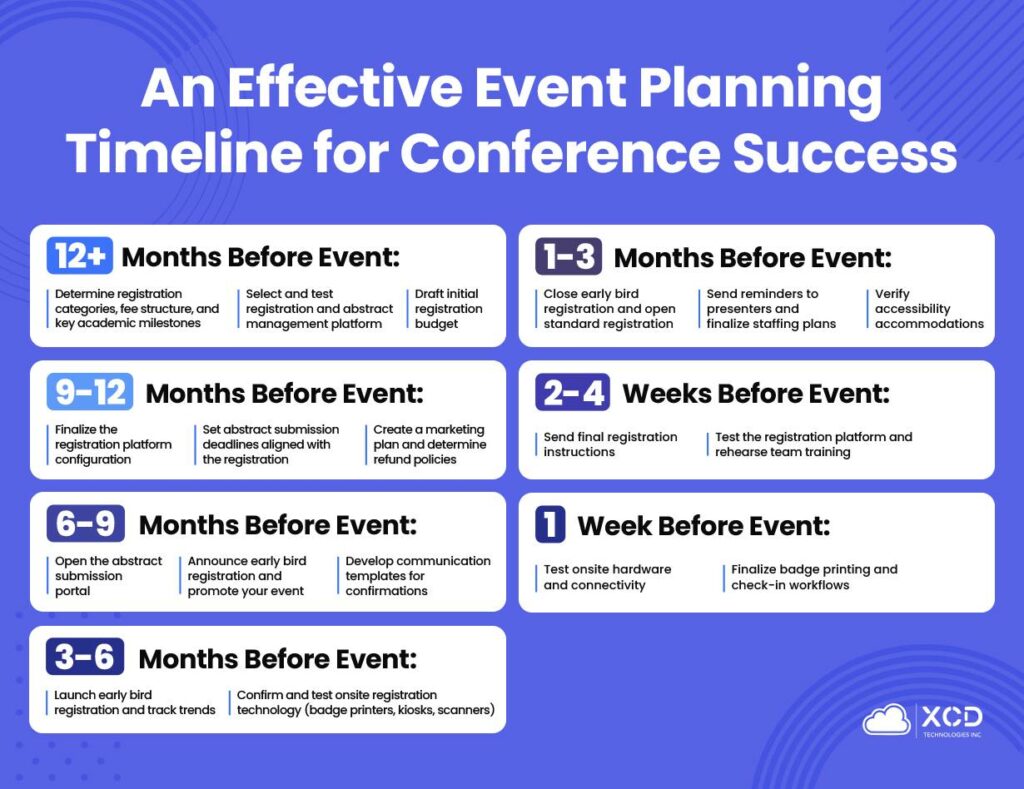It’s been said that first impressions are everything, and when it comes to events, that first impression starts with registration.
The moment an attendee lands on your registration page, they begin forming opinions about your event’s organization, professionalism, and overall experience.
A smooth registration process reassures them they’ve made the right choice in signing up. But a clunky, confusing, or frustrating registration experience? That can lead to abandoned sign-ups, repeated support inquiries, and a negative perception before your event even begins.
In this guide, we’ll explain how to optimize your registration process from A to Z, so you can boost sign-ups, reduce stress, and set the stage for a flawless event.
Assessing Your Registration Needs: The Planning Phase
Successful registration begins long before your first attendee signs up.
The planning phase lays the foundation for everything that follows, ensuring you have clear objectives, realistic timelines, and adequate resources.
Setting Clear Registration Goals and KPIs
While registration is focused on collecting attendee information, it’s also about gathering the right data and supporting your event’s financial sustainability. That’s why it’s important to start by defining specific, measurable goals for your registration process, including:
- Attendance targets: Set realistic goals for total registrations and breakdown by attendee type (researchers, faculty, students, industry professionals.)
- Revenue objectives: Establish target revenue from registration fees, considering early bird discounts and special rates.
- Conversion metrics: Define expected conversion rates based on registration goals or historical data from previous attendees.
- Data collection: Determine what essential information you need to gather beyond basic contact details (research interests, dietary needs, accessibility requirements.)
- User experience: Set benchmarks for registration completion time and abandonment rates.
Creating a Registration Timeline and Checklist
Academic and scientific conferences typically operate on longer planning cycles than other events, often spanning 12-18 months due to their complex structure, which includes:
- Calling for abstracts and peer review
- Securing speakers and keynotes
- Planning venue and logistics
- Getting funding and sponsorships
Your registration timeline should account for this extended conference schedule. Our suggested timeline is:

Budgeting Effectively for Registration Technology and Staffing
A well-planned budget ensures you have the necessary resources, such as reliable registration software, adequate staffing, and essential onsite equipment for your event.
While you create your budget, we encourage you to:
Allocate Budget Based on Priorities
Determine where to allocate the most resources based on your event’s needs. For example, a large academic or science conference may require robust registration software to manage the registration process rather than relying on spreadsheets.
Evaluate Cost vs. Value
Invest in solutions that offer both efficiency and a great attendee experience. A reliable registration platform may have a higher upfront cost but can reduce manual work, minimize errors, and improve attendee satisfaction.
Building a Registration System That Works: The Setup Phase
With your registration plan established, the next step is selecting the right technology solution. This is where many academic and science conference organizers encounter difficulties, as systems that lack integration often fail to accommodate the specialized workflows of these events.
Choosing the Right Registration Software
When evaluating registration platforms for academic or scientific conferences, we suggest prioritizing the following essential features:
- Dynamic Pricing for Attendees: Enables accurate registration rates based on membership types.
- Effortless Payment Integration: Supports multiple payment gateways for secure and flexible transactions.
- Seamless AMS Integration: Connects with Association Management Systems for real-time data synchronization.
- Customizable Registration Forms: Provides flexible fields and tailored workflows to collect only relevant information.
- Automated Capacity Management: Manages event capacity with automated waitlist notifications.
- Personalized Certificates of Attendance: Generates customized certificates for a professional touch and valuable keepsake.
To make the event management process even simpler, X-CD’s platform offers complete integration for:
- Abstract submission and review
- Session scheduling and room management
- Attendee registration with dynamic pricing
- Exhibitor and sponsor management
- A mobile event app with personalized agendas
- Onsite check-in and badge printing
- Post-event analytics and reporting
Crafting an Irresistible Registration Experience: The Design Phase
While functional capabilities form the backbone of your registration system, the design phase focuses on creating an experience that engages attendees and maximizes conversions. For academic or scientific conferences, this means balancing professional presentation with optimal information collection.
Designing User-Friendly Registration Forms and Workflows
The structure of your registration form directly impacts completion rates. Academic and scientific conferences often require more detailed information than other events, making a streamlined format even more crucial. Here are some tips to consider:
Form Design Best Practices:
- Group related questions into logical sections (personal information, academic details, session selection)
- Use clear, concise labels with additional context where needed
- Implement appropriate field types (radio buttons for single selections, checkboxes for multiple options)
- Display only essential fields, moving optional information to secondary screens
Workflow Best Practices:
- Present the most critical information first
- Use conditional logic to create branching paths based on the registrant type
- Provide clear navigation between registration steps
- Allow users to review and edit their information before submission
- Ensure accessibility compliance for users with disabilities
Customizing the Registration Process for Different Attendee Types
Similarly to most events, academic and scientific conferences have different attendee types, each with unique registration requirements. We’ve listed the key points to be mindful of when customizing the registration process and collecting information for various types of attendees.
General Attendees:
- Streamlined registration with basic biographical and contact information
- Session selection options based on interests
- Networking preferences and profile visibility settings
- Continuing education tracking requirements
Presenters and Speakers:
- Integration with abstract acceptance status
- Additional biographical information for conference proceedings
- Presentation technical requirements
- Permission settings for recording and sharing content
Exhibitors and Sponsors:
- Company profile information and logo uploading
- Booth selection capabilities with interactive floor plans
- Staff registration allocation and management
- Add-on opportunities for increased visibility
VIPs and Committee Members:
- Special access codes for complimentary registration
- Committee meeting scheduling integration
- Recognition preferences for program acknowledgments
- Special accommodation requirements
Implementing Dynamic Pricing Strategies
Academic and scientific conferences usually have pricing models that cater to the different types of attendees. Effective pricing strategies include:
Early Bird Discounts:
- Tier discounts based on submission deadlines
- Create urgency with clearly communicated cut-off dates
- Offer substantial savings to encourage early commitment
- Use early registration data to inform planning decisions
Group Registration Discounts:
- Create delegation packages for multiple attendees from the same institution
- Implement progressive discounts that increase with group size
Membership-Based Pricing:
- Integrate with association databases to verify membership status
- Offer differentiated pricing based on membership levels
- Provide non-member rates that include membership options
Streamlining the Onsite Check-In Process: The Execution Phase
After months of planning, the moment of truth arrives when attendees begin checking in. For academic and scientific conferences, an efficient onsite process reinforces your event’s professionalism and sets the tone for the entire experience.
Setting up Self-Service Kiosks for Efficient Check-In
Self-service technology transforms academic and scientific conference check-in by reducing wait times, which improves the attendee experience.
We encourage you to position kiosks at main entrance points with clear signage and create dedicated lanes for pre-registered versus onsite registrations.
Implementing QR Code Scanning for Instant Verification
QR code technology streamlines check-in while enhancing security.
Some of the best ways to streamline the scanning process are to:
- Include personalized QR codes in confirmation emails
- Offer mobile wallet integration for digital storage
- Enable instant verification of registration status
- Extend functionality to session tracking and networking
Printing Badges On-Demand vs. Pre-Printing Badges
Pre-printing event badges may feel more productive, but on-demand badge printing offers significant advantages.
By printing onsite during check-in, you can:
- Eliminate waste from no-show attendees
- Allow last-minute information updates
- Reduce pre-event preparation and shipping costs
- Enable personalization based on onsite selections
How X-CD Can Help With Your Event Management Registration Process
The journey from initial registration planning to onsite badge printing represents the critical path to your event’s success.
Each step in this process, from strategic planning and system selection to design optimization and onsite execution, creates a seamless experience that sets the tone for your entire event.
Key Takeaways
- First Impressions Matter: Your registration process is the first interaction attendees and exhibitors have with your event, shaping their overall experience and perception.
- Strategic Planning is Essential: Setting clear goals, establishing realistic timelines, and budgeting appropriately helps you achieve financial health.
- Integrated Systems Save Time: You can eliminate the headaches of juggling multiple platforms by choosing an integrated solution, such as X-CD.
- User Experience Drives Completion: Thoughtfully designed registration forms with logical workflows significantly increase completion rates and reduce abandonment.
- Personalization Improves Results: Tailoring your registration experience for different attendee types and implementing dynamic pricing strategies can maximize participation.
- Onsite Execution Determines Success: Self-service kiosks, QR code scanning, and on-demand badge printing transform check-in from a potential bottleneck to a smooth, welcoming experience.
X-CD’s comprehensive event management platform addresses these critical areas through one integrated solution. Our platform is specifically designed to accommodate the unique requirements of academic and scientific conferences, with flexible workflows, secure data handling, and intuitive onsite tools.
Ready to transform your registration process from a potential pain point into a standout strength? Request a demo to see how X-CD can elevate your next event registration experience.




